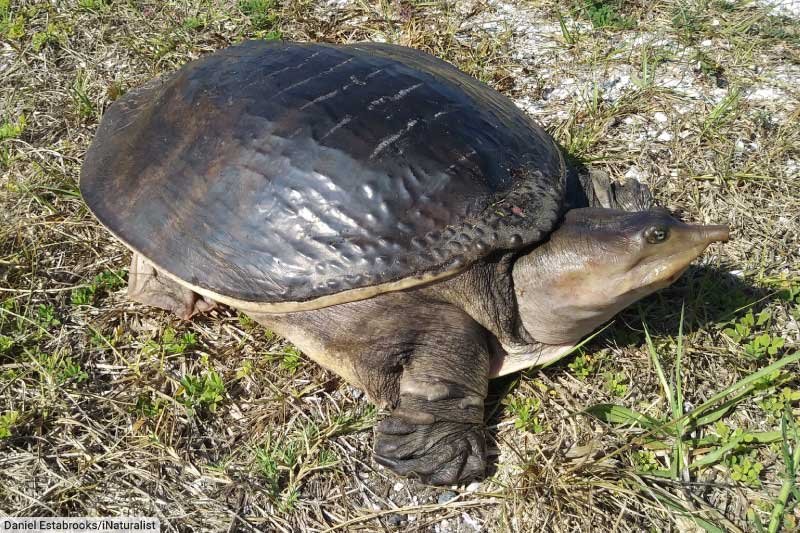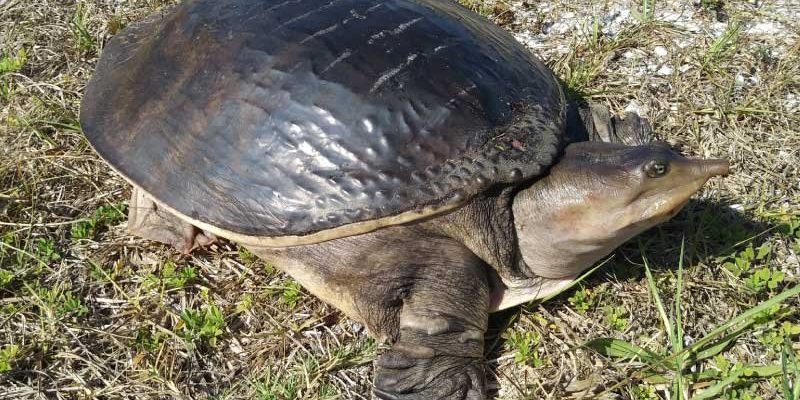
When you think of turtles, you might picture hard, protective shells and a slow, steady pace. But have you ever met the Softshell Turtle? These fascinating creatures turn that image upside down. With their flexible, leathery shells and unique adaptations, softshell turtles stand out in the world of reptiles. They are not just a quirky twist on the classic turtle; they bring their own set of incredible traits that make them truly remarkable.
Imagine a turtle that can swim faster than most of its relatives and has the ability to lie quietly at the bottom of rivers or lakes, blending into its surroundings. That’s the softshell turtle for you! They can be found in various habitats, from warm rivers to freshwater ponds, and they have some interesting behaviors that make them different from other turtles. Let’s dive deeper into what makes these turtles so special.
What is a Softshell Turtle?
The softshell turtle belongs to the family Trionychidae, a group of turtles known for their unique features. Unlike the typical hard-shelled turtles, softshell turtles have a flexible, soft carapace. This leather-like shell is more like the surface of a basketball than the hard shells of their cousins. This unique design allows them to be more mobile in the water. You might be surprised to learn that softshell turtles can actually reach impressive lengths, often growing between 10 to 30 inches, depending on the species.
Softshell turtles are widely distributed across North America, Asia, and Africa. Each region has its own species, such as the common softshell turtle found in North America and the Asian softshell turtles, which include fascinating varieties like the Indian softshell turtle. Each species has adapted to its environment in unique ways, showcasing how adaptable these creatures can be.
Physical Characteristics
One of the most striking things about the softshell turtle is its appearance. While most turtles have a hard, bumpy shell, softshell turtles sport a smooth, flat, and pliable shell that can be brown, olive, or grayish in color, helping them camouflage in their natural habitats. Their snouts are elongated, giving them a unique facial profile that resembles a snorkel. This adaptation is no accident; it allows them to breathe while mostly submerged, like a diver peeking above the surface.
Their limbs are also different. Unlike other turtles, softshells have long, paddle-like limbs that help them swim quickly through the water. If you’ve ever watched a turtle waddle on land, you’ll appreciate how gracefully softshells glide through their aquatic environments. They might even surprise you with their speed when they decide to take off!
Habitat & Range
Softshell turtles thrive in both freshwater and brackish water environments. You’ll often find them in rivers, lakes, ponds, and even marshes. They prefer places with sandy or muddy bottoms where they can burrow and hide from predators. This ability to bury themselves helps them stay safe from hungry animals while they wait patiently for their next meal. It’s pretty ingenious, right?
In terms of geography, softshell turtles have a wide range. In North America, they inhabit areas from the Mississippi River Basin to parts of the East Coast. In Asia, you can find various species in countries like India and China. Despite their wide distribution, some species face threats due to habitat loss and pollution, making conservation important for their survival.
Diet and Feeding Habits
When it comes to food, softshell turtles are omnivorous, meaning they enjoy a diverse diet. They primarily feed on aquatic plants, fish, crustaceans, and even insects. Their flexible necks allow them to reach out to snatch prey with surprising speed. It’s like having a dinner party where they serve a bit of everything!
Interestingly, softshell turtles are known to use a technique called ambush feeding. They’ll often stay completely still, waiting for unsuspecting fish or other small prey to swim by before making a quick strike. This strategy not only conserves energy but also increases their chances of catching something tasty. You might say they’re the stealthy ninjas of the turtle world!
Behavior and Adaptation
Softshell turtles are fascinating creatures with a handful of behaviors that aid their survival. For starters, they are primarily active during the day, mostly basking in the sun to regulate their body temperature. However, don’t be fooled into thinking they are just sunbathers; they also spend a lot of time hunting in the water. Their ability to absorb oxygen through their skin allows them to remain submerged for extended periods, making them skilled hunters.
You might notice that softshell turtles are social animals. They often congregate in groups during basking sessions. It’s not uncommon to see them piled on top of one another, soaking up the sun’s rays. This social behavior might help them establish dominance and maintain territory, which is essential in the wild.
Reproduction and Lifespan
Softshell turtles breed in warm seasons, typically in late spring or early summer. Females will lay anywhere from 9 to 30 eggs in sandy areas near water. After about 60-70 days, the eggs hatch, and the young turtles make their way to the water, starting their journey in life. It’s a perilous time, as many predators, including birds and mammals, are on the lookout for these vulnerable hatchlings.
In terms of lifespan, softshell turtles can live quite a long time. In the wild, they typically reach ages of 20 to 30 years, although some can live even longer under the right conditions. This longevity reflects their adaptability and resilience in various environments. It’s a reminder that even fragile-seeming creatures can thrive and prosper with the right balance of care and protection.
Conservation Status
While some species of softshell turtles are thriving, others are facing serious threats. Habitat destruction, pollution, and hunting have negatively impacted several populations. For instance, the Yangtze giant softshell turtle is critically endangered and is one of the rarest turtles in the world. Conservation efforts are crucial to protect these fascinating creatures and their habitats.
Conservation organizations are working tirelessly to preserve the remaining softshell turtle species. Initiatives range from habitat restoration to breeding programs to prevent extinction. Supporting these efforts can help ensure that future generations can marvel at the wonders of softshell turtles.
Interesting Facts
Softshell turtles are full of surprises! Here are some fun facts that might make you appreciate them even more:
- Softshell turtles can hold their breath for up to several hours, allowing them to remain submerged without needing to surface.
- They have excellent vision underwater, which helps them locate prey even in murky waters.
- The leather-like shell is not just for show; it helps them stay buoyant while swimming.
- They can be quite aggressive when threatened, often using their long-necked snouts to defend themselves.
Softshell turtles truly are remarkable creatures that defy the typical turtle stereotype. With their unique adaptations, behaviors, and habitats, they offer a world of intrigue beneath the water’s surface. Whether you come across them basking in the sun or gliding gracefully through water, it’s clear that softshell turtles have a special place in our ecosystems. Learning about and advocating for their conservation is essential to ensuring that these fascinating animals continue to thrive in the wild.
FAQ
What do softshell turtles eat?
Softshell turtles are omnivorous, feeding on a variety of items. Their diet mainly consists of aquatic plants, insects, fish, and crustaceans. They have a knack for ambushing their prey, waiting patiently until the right opportunity arises to strike. This hunting technique helps them conserve energy while maximizing their chances of catching something tasty.
Where do softshell turtles live?
Softshell turtles are found in diverse environments, including rivers, lakes, ponds, and marshes. They prefer areas with sandy or muddy bottoms where they can bury themselves for protection. Their range spans multiple continents, including North America, Asia, and Africa, with different species adapted to their specific habitats.
How fast can a softshell turtle swim?
Softshell turtles are surprisingly fast swimmers, thanks to their long, paddle-like limbs. They can reach speeds of around 1.5 to 2.5 miles per hour in the water, which is quite impressive for a turtle. This speed helps them evade predators and catch their prey effectively.
Are softshell turtles social animals?
Yes, softshell turtles are known to be social creatures. They often gather in groups, especially during basking sessions. This social behavior helps them establish territory and can also provide some safety in numbers against potential threats.
How long do softshell turtles live?
Softshell turtles can live a long time, with life spans typically ranging from 20 to 30 years, depending on the species and environmental conditions. Some individuals have been known to live even longer in safe, controlled environments such as zoos and conservation centers.
What are the main threats to softshell turtles?
Softshell turtles face several threats, including habitat destruction, pollution, and hunting. These factors have contributed to the decline of certain species, making conservation efforts crucial for their survival. Protecting their natural habitats and mitigating human impact are essential steps toward ensuring their future.
Can softshell turtles breathe underwater?
Softshell turtles can’t breathe underwater like fish, but they have the ability to absorb oxygen through their skin, especially when submerged. This adaptation allows them to remain underwater for extended periods without needing to surface for air frequently, making them adept at hunting and hiding.
How do softshell turtles defend themselves?
When threatened, softshell turtles can be quite aggressive. They may use their long snouts to strike at predators or burrow into the mud or sand for protection. Their flexible shells also allow them to maneuver quickly to evade danger, making them well-equipped for survival.
Are softshell turtles endangered?
While some softshell turtle species are doing well, others are critically endangered. Factors such as habitat loss, pollution, and hunting have placed specific species, like the Yangtze giant softshell turtle, at risk. Conservation efforts are vital to help protect these vulnerable turtles and their habitats.
What is the role of softshell turtles in their ecosystems?
Softshell turtles play an important role in their ecosystems. As both predators and prey, they help maintain the balance of aquatic food webs. By feeding on various organisms, they contribute to nutrient cycling and help regulate populations of their prey, making them a key component of their habitats.

